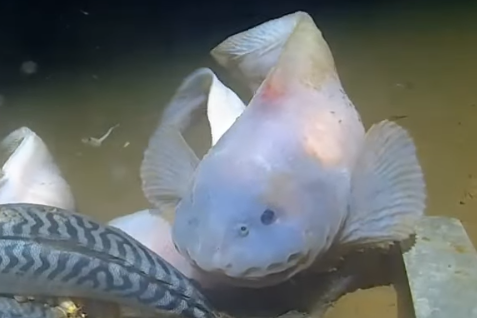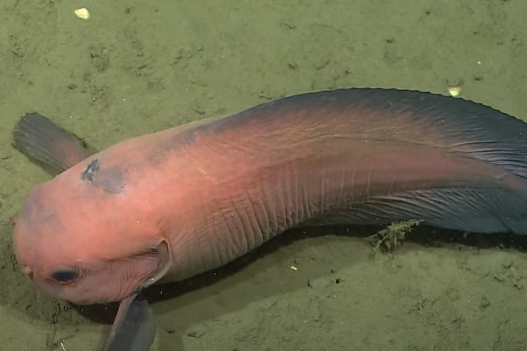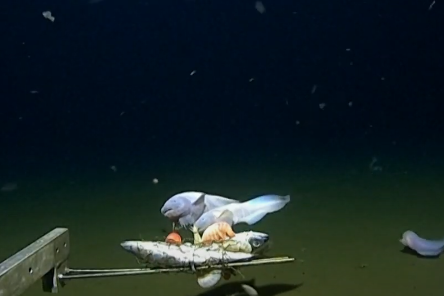Meet the Deepest Dweller: The Mariana Snailfish

Imagine a world so dark, so cold, and so hostile that it seems impossible anything could survive there. Yet, deep below the waves, the Mariana snailfish holds the record as the deepest-living animal ever discovered. Scientists found these remarkable creatures swimming nearly 27,000 feet below the ocean’s surface, in a place where the water pressure is like having 1,600 elephants standing on top of you.
Despite living in such an extreme environment, the Mariana snailfish looks surprisingly delicate. It has a soft, translucent body that seems more suited for a calm pond than the crushing depths of the Mariana Trench. Experts explain that this incredible animal has evolved special adaptations that let it thrive where almost nothing else can. Its story isn’t just about survival — it’s about nature’s endless creativity in the face of unimaginable challenges.
Why Crushing Pressure Should Flatten Them But Doesn’t
At the depth where the Mariana snailfish lives, the pressure would instantly destroy a human body or even a modern submarine. You would think that any living thing would get flattened like a pancake. But the snailfish has some genius survival tricks up its slippery sleeve. Instead of having a rigid, brittle body that would crack under pressure, it evolved to be soft and squishy, able to bend and flex with the immense weight of the ocean above.
Marine biologists explain that the key to surviving such crushing pressure lies in the fish’s cellular structure. Its flexible bones and special proteins keep it from collapsing under extreme stress. These adaptations allow its body to move with the pressure instead of fighting against it. It’s a little like how a rubber ball can handle being squeezed from every direction without breaking. Living proof that sometimes being soft is actually a superpower.
Special Proteins Are Their Secret Armor
The Mariana snailfish doesn’t rely on tough scales or a hard skeleton for protection. Instead, its greatest weapon against crushing deep-sea pressure is microscopic: special proteins called “piezolytes.” These tiny molecules help keep the fish’s enzymes and cells functioning even when the external pressure should logically squash everything into oblivion.
Experts who study deep-sea biology highlight how these proteins are vital for survival in the abyss. In normal conditions, proteins inside living things can warp and malfunction under pressure. But in the snailfish, piezolytes act like little bodyguards, stabilizing crucial molecules and allowing the animal to keep living, eating, and swimming normally. Without these biological adaptations, life at such profound depths would be impossible. In a world where strength often looks tough and armored, here it’s the invisible strength inside cells that wins the day.
Their Bones Are Softer Than You’d Expect
When you picture an animal tough enough to survive Earth’s most extreme depths, you might imagine one armored in thick plates or a skeletal tank. But the Mariana snailfish flips that expectation on its head. Its bones are incredibly soft, almost gelatinous compared to land animals or even regular fish living closer to the surface.
Scientists explain that hard bones would actually be a major disadvantage at such depths. The pressure could cause them to crack or break. Instead, soft bones flex and move with the external force, preventing serious damage. It’s a bit like the difference between snapping a dry twig and bending a rubber band. This softness also gives the snailfish its characteristic floppy look, almost as if it is melting into the water around it. Every part of its structure is built not for resistance, but for graceful, effortless survival against nature’s hardest conditions.
They Don’t Have Much Competition Down There

In the deepest parts of the ocean, life is so sparse that the Mariana snailfish doesn’t have many rivals to worry about. No sharks, no predatory squid, and certainly no humans. It has carved out a kingdom in the extreme quiet, where the pressures are lethal and food is scarce but competition is almost nonexistent.
Deep-sea ecologists point out that living so far below the surface allows these animals to avoid most of the typical threats found in shallower waters. Instead of fighting for food or dodging larger predators, the snailfish spends its life slowly cruising the depths, snapping up tiny crustaceans and shrimp that drift down from the surface. Its adaptations are not just about surviving crushing pressure but also about making the most of a calm, eerie world where almost nothing else dares to roam.
They Have Unique Vision Suited for the Deep
You might expect a creature living in total darkness to be completely blind, but the Mariana snailfish still has functioning eyes — they’re just adapted for its inky black world. Its vision isn’t tuned for sunlight because it never sees any. Instead, it’s finely tuned to detect the faintest glimmers of bioluminescence — the eerie glow some deep-sea creatures produce.
Experts explain that rather than relying on sharp, detailed vision, the snailfish uses its eyes to sense slight changes in light, helping it locate prey or avoid hazards. In a world where sunlight never penetrates and the concept of “day” and “night” doesn’t even exist, this kind of specialized eyesight is essential. It’s another reminder that in the extreme depths, survival doesn’t mean doing what works up here — it means finding entirely new ways to live and thrive.
They Thrive at Bone-Chilling Temperatures
Imagine living your entire life in a place where the temperature barely creeps above freezing. The Mariana Trench, home to the deepest animals like the Mariana snailfish, stays around 34 to 39 degrees Fahrenheit all year long. For most creatures, these icy temperatures would slow down body processes to a crawl or even freeze them to death. But for the snailfish, this chilly world is home sweet home.
Marine scientists explain that the snailfish’s body is specially adapted to work efficiently even in cold temperatures. Its enzymes and metabolism have evolved to function in near-freezing waters without a hitch. It doesn’t waste energy trying to stay warm because its entire biological system is built to embrace the cold. Where most animals would need antifreeze-like chemicals or heat generation tricks, the snailfish simply leans into the chill. It’s another incredible example of how life doesn’t just survive in extreme conditions but actually flourishes when perfectly adapted.
They Feed on Falling “Marine Snow”
At the crushing depths where light never reaches, plants can’t grow and traditional food chains collapse. So how does the deepest animal ever discovered find something to eat? It turns out that their dinner comes from above — in the form of “marine snow,” a steady drift of tiny organic particles falling from the upper ocean layers.
Scientists describe marine snow as a mixture of dead plankton, fish scales, poop, and other tiny bits of debris. While it might sound unappetizing, for deep-sea creatures like the Mariana snailfish, it’s an absolute feast. With so little energy available in the deep ocean, snailfish have adapted to be opportunistic feeders, grabbing whatever drifts down to their realm. This remarkable strategy allows them to survive in an environment where a steady meal is a luxury and every falling particle counts. It’s a slow-motion survival game where patience and adaptability win.
Their Skin Is Built for Extreme Environments
Living under crushing pressure and constant cold requires some serious modifications, not just inside but outside as well. The Mariana snailfish’s skin is delicate but resilient, built to withstand incredible physical and chemical stress. It’s not tough like sharkskin or armored like a turtle’s shell, but it performs an equally impressive job in a very different environment.
Researchers explain that their skin plays a crucial role in maintaining fluid balance under immense pressure. It helps manage what little oxygen and nutrients are available, while also offering some protection against the chemical soup of the deep ocean. Despite looking almost ghost-like in appearance, their skin is actually a sophisticated survival tool. It’s a reminder that in nature, the most vital defenses are not always visible to the naked eye but are fine-tuned by millions of years of evolution to handle even the harshest conditions.
They Reproduce in the Darkness
Imagine trying to find a mate in a place where you can’t see more than a few inches around you. Despite the darkness and the sheer vastness of the deep ocean, the Mariana snailfish has developed strategies to find and reproduce with its own kind. Scientists believe that chemical signals, rather than visual cues, help these animals locate potential mates in the eternal night of the abyss.
Because the energy cost of survival is so high in the deep sea, reproduction must be efficient. Snailfish are thought to produce fewer offspring than surface-dwelling species, but they invest heavily in each one, ensuring that the young are well-prepared for the brutal world they’ll be born into. Their reproductive cycle is finely tuned to the rhythms of the deep ocean, where resources are limited and the stakes of survival are sky-high. In the crushing, frozen, pitch-black world of the Mariana Trench, life still finds a way to continue.
Deep-Sea Exploration Revealed Them Only Recently
It’s mind-blowing to realize that the deepest-living snailfish was only discovered in the last few decades. For most of human history, the deep sea was an unexplored mystery, a place of myths and guesses. It took advanced submersibles, robotic technology, and years of research to finally catch a glimpse of these creatures living their invisible lives at the bottom of the ocean.
Oceanographers point out that deep-sea exploration is still incredibly difficult even today. Sending a craft down nearly seven miles under the surface takes an enormous amount of engineering, patience, and bravery. Every time researchers dive deeper, they find new wonders that expand our understanding of what life can endure. The discovery of the Mariana snailfish is not just a biological achievement but a testament to human curiosity and technological progress. Who knows what other incredible animals might still be lurking even deeper, waiting to be found?
They Inspire New Ideas for Human Technology

Believe it or not, studying how the Mariana snailfish survives crushing pressure is already inspiring new advances in human technology. Engineers are looking at the snailfish’s unique proteins, bones, and cellular structures to design better deep-sea vehicles, pressure-resistant materials, and even medical breakthroughs. Nature, it turns out, often holds the answers to problems we haven’t fully solved yet.
Marine biologists and material scientists are working together to see how the strategies evolved by deep-sea creatures can be mimicked by humans. Whether it’s building stronger underwater drones or creating new ways to protect sensitive equipment in harsh environments, the secrets of the Mariana snailfish are quietly influencing the future. It’s another beautiful twist in the story — how one tiny, floppy-looking fish living in complete darkness might help us conquer the toughest challenges here on the surface.
